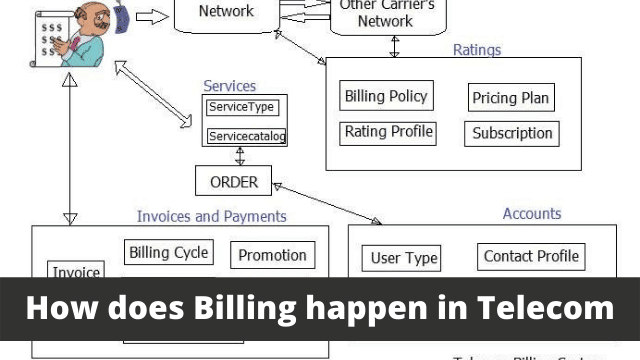How does Billing happen in Telecom? Telecom billing is the process of collecting and grouping usage of telecom products or services for specific customers or accounts. This helps to record their transactions, to generate and send records, invoices, as well as payments made to specific accounts.
Typically, telecom billing consists of the following types of charges:
- Rental charges – these are the monthly or annual costs paid by clients each month for the services that they get.
- Usage charges – this is where a telecom company receives payments from different clients depending on their usage. For example, a client pays their telecom services provider depending on the data downloaded on their phone or the number of calls they make over a specified period of time.
Also, it is important to note that telecom service providers can charge a specific fee for service installation or initiation, or rental charges, in addition to your monthly charges.
Related Article: Are Software Engineers Still in Demand
The purpose of telecom billing
The primary purpose of telecom billing include:
- Managing the billing process of users for the services that they use
- Automating the majority of the labor-intensive work of telecom billing
- Optimizing the efficiency of the entire billing process, while saving critical resources like time and money
Now, a telecom billing software like telecom billing software, Kansys calculates, generates, and dispatches bills to individual customers, depending on their usage of telecom services. Besides, it helps to monitor how customers are making their payments, as well as whether there are any pending debts. Typically, the bills include voice charges, as well as connectivity services. However, because of the ever-growing range of telecom services provided by some telecom companies today, the bills can also include charges for IT services, support, one-off charges, software licenses, consultancy, and hardware costs, among others costs.
For the connectivity and voice charges, a telecom billing will process usage data depending on call detail records or CDRs. The CDRs are created whenever a client places a call, accesses the internet, or sends a message using a communications network. A telecom billing system will rate the usage according to the client’s tariff, to determine the cost the client has incurred over the billing period (mostly a month).
Read Also: What you need to know about simple invoicing.
How does Billing happen in Telecom, Besides calculating the costs of service usage by clients, a billing system also monitors the costs of service a communications provider is buying from suppliers. Typically, this involves checking to make sure that all the charges are accurate and in line with the agreed costs. Also, a billing system provides revenue assurance by making sure that all the supplier costs match the charges in the client’s bill. This ensures that the telecom service provider doesn’t miss anything, and it alerts the provider if a loss-making service is identified.
How telecom billing happens
By now, you understand that telecom billing is a complicated process. Because of this, we shall highlight the most commonly used billing types.
- Pre-paid billing – this is a telecom billing method where the customer pays the communications provider in advance before receiving their services. Typically, a prepaid client doesn’t receive an invoice from the service provider, as they get charged according to their real-time usage by a billing system known as Intelligent Network (IN).
- Post-paid billing – this is the most common telecom billing method, and it’s been in use for many years. Here, the client uses telecom services throughout the entire month. At the end of the month, the billing system generates an invoice, and then sends the invoice to the client, notifying them to make their payment.
- Interconnect billing – here, the telecom service provider is financially responsible for the services their clients receive from other networks—irrespective of whether or not the clients pay for these services. This type of telecom billing is related to an inter-carrier, also known as partner settlements at times.
- Roaming charges – if a client moves from an area with another network operator’s coverage, their original operation will be required to pay the other operator some marginal charges to provide telecom charges to their clients. Now, such kinds of telecom charges are only settled via roaming billing, and the settlement is done following the TAP3 protocol.
- Convergent billing – this is the integration of different service charges into one client invoice. With convergent telecom billing, the billing system creates an integrated view of the client and the services that the client receives.
Unused features in telecom billing
How does Billing happen in Telecom, These are extra services offered by CPs that people forget about. Most telecom service providers entice users to buy features when signing up for the first time to make the most out of the service they are delivering.
However, there is a way to tell whether you have any unused features, which can be removed from your package. The best way to do it is to review each phone line, isolate the users of the line, and ask the features they are currently using. So, if a user hasn’t used a feature in the last 90 days, that’s an indicator that you don’t need it, meaning it should be removed.

Hello, My name is Shari & I am a writer for the ‘Outlook AppIns’ blog. I’m a CSIT graduate & I’ve been working in the IT industry for 3 years.
